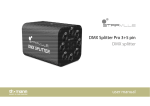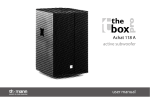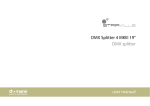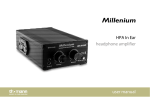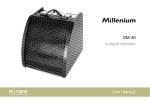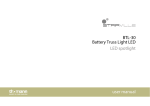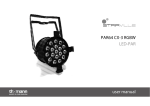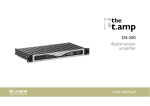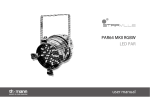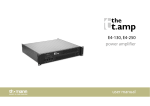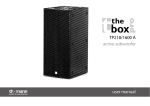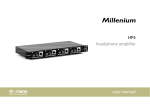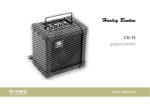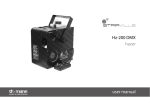Download WLS-DMX transceiver user manual
Transcript
WLS-DMX transceiver user manual Musikhaus Thomann Thomann GmbH Hans-Thomann-Straße 1 96138 Burgebrach Germany Telephone: +49 (0) 9546 9223-0 E-mail: [email protected] Internet: www.thomann.de 20.08.2015, ID: 366876 Table of contents Table of contents 1 General notes............................................................................................................................................... 1.1 Further information........................................................................................................................... 1.2 Notational conventions.................................................................................................................... 1.3 Symbols and signal words............................................................................................................... 4 5 6 7 2 Safety instructions..................................................................................................................................... 9 3 Features....................................................................................................................................................... 13 4 Installation.................................................................................................................................................. 14 5 Starting up.................................................................................................................................................. 15 6 Connections and controls................................................................................................................... 19 7 Operating.................................................................................................................................................... 25 8 Technical specifications....................................................................................................................... 30 9 Plug and connection assignments.................................................................................................. 31 10 Troubleshooting...................................................................................................................................... 32 11 Protecting the environment.............................................................................................................. 35 WLS-DMX 3 General notes 1 General notes This manual contains important instructions for the safe operation of the unit. Read and follow the safety instructions and all other instructions. Keep the manual for future reference. Make sure that it is available to all those using the device. If you sell the unit please make sure that the buyer also receives this manual. Our products are subject to a process of continuous development. Thus, they are subject to change. transceiver 4 General notes 1.1 Further information On our website (www.thomann.de) you will find lots of further information and details on the following points: Download This manual is also available as PDF file for you to download. Keyword search Use the search function in the electronic version to find the topics of interest for you quickly. Online guides Our online guides provide detailed information on technical basics and terms. Personal consultation For personal consultation please contact our technical hotline. Service If you have any problems with the device the customer service will gladly assist you. WLS-DMX 5 General notes 1.2 Notational conventions This manual uses the following notational conventions: Letterings The letterings for connectors and controls are marked by square brackets and italics. Examples: [VOLUME] control, [Mono] button. Displays Texts and values displayed on the device are marked by quotation marks and italics. Examples: ‘24ch’ , ‘OFF’ . transceiver 6 General notes Instructions The individual steps of an instruction are numbered consecutively. The result of a step is indented and highlighted by an arrow. Example: 1. Switch on the device. 2. Press [Auto]. ð Automatic operation is started. 3. Switch off the device. 1.3 Symbols and signal words In this section you will find an overview of the meaning of symbols and signal words that are used in this manual. WLS-DMX 7 General notes Signal word Meaning DANGER! This combination of symbol and signal word indicates an immediate dangerous situation that will result in death or serious injury if it is not avoided. NOTICE! This combination of symbol and signal word indicates a pos‐ sible dangerous situation that can result in material and environmental damage if it is not avoided. Warning signs Type of danger Warning – high-voltage. Warning – danger zone. transceiver 8 Safety instructions 2 Safety instructions Intended use This device is intended for the wireless transmission of DMX signals in lighting systems. Use the device only as described in this user manual. Any other use or use under other operating conditions is considered to be improper and may result in personal injury or property damage. No liability will be assumed for damages resulting from improper use. This device may be used only by persons with sufficient physical, sensorial, and intellectual abilities and having corresponding knowledge and experience. Other persons may use this device only if they are supervised or instructed by a person who is responsible for their safety. Safety DANGER! Danger for children Ensure that plastic bags, packaging, etc. are disposed of properly and are not within reach of babies and young children. Choking hazard! Ensure that children do not detach any small parts (e.g. knobs or the like) from the unit. They could swallow the pieces and choke! Never let children unattended use electrical devices. WLS-DMX 9 Safety instructions DANGER! Electric shock caused by high voltages inside Within the device there are areas where high voltages may be present. Never remove any covers. There are no user-serviceable parts inside. Do not use the device if covers, protectors or optical components are missing or damaged. DANGER! Electric shock caused by short-circuit Always use proper ready-made insulated mains cabling (power cord) with a pro‐ tective contact plug. Do not modify the mains cable or the plug. Failure to do so could result in electric shock/death or fire. If in doubt, seek advice from a regis‐ tered electrician. transceiver 10 Safety instructions NOTICE! Risk of fire Do not cover the device nor any ventilation slots. Do not place the device near any direct heat source. Keep the device away from naked flames. NOTICE! Operating conditions This device has been designed for indoor use only. To prevent damage, never expose the device to any liquid or moisture. Avoid direct sunlight, heavy dirt, and strong vibrations. WLS-DMX 11 Safety instructions NOTICE! Power supply Before connecting the device, ensure that the input voltage (AC outlet) matches the voltage rating of the device and that the AC outlet is protected by a residual current circuit breaker. Failure to do so could result in damage to the device and possibly injure the user. Unplug the device before electrical storms occur and when it is unused for long periods of time to reduce the risk of electric shock or fire. NOTICE! Possible staining The plasticiser contained in the rubber feet of this product may possibly react with the coating of your parquet, linoleum, laminate or PVC floor and after some time cause permanent dark stains. In case of doubt, do not put the rubber feet directly on the floor, but use felt-pad floor protectors or a carpet. transceiver 12 Features 3 Features Special features of the device: n n n n n n n Switchable operating mode: Transmitter or receiver Wireless signal transmission in frequency range 2.4 GHz (ISM band) without interference Toll-free operation in the EU and NAFTA countries, no permit required Operation via button on the unit Three LEDs for monitoring the operating status Lockable powerCON input socket (NAC3FA) for mains connection. Mounting bracket and powerCON mains cable supplied WLS-DMX 13 Installation 4 Installation Unpack and carefully check that there is no transportation damage before using the unit. Keep the equipment packaging. To fully protect the device against vibration, dust and moisture during transportation or storage use the original packaging or your own packaging material suitable for transport or storage, respectively. NOTICE! Possible data transmission errors For error-free operation make use of dedicated DMX cables and do not use ordi‐ nary microphone cables. Never connect the DMX input or output to audio devices such as mixers or ampli‐ fiers. transceiver 14 Starting up 5 Starting up Create all connections while the device is off. Use the shortest possible high-quality cables for all connections. Take care when running the cables to prevent tripping hazards. WLS-DMX 15 Starting up Point-to-point connection Connect a device configured as transmitter to the DMX output of your DMX controller and a device configured as receiver to the DMX input of the first DMX device in the DMX chain that is to be controlled. In this point-to-point configuration the DMX signal from one transmitter is sent to one receiver. transceiver 16 Starting up Point-to-multipoint connection Connect a device configured as transmitter to the DMX output of your DMX controller and a device configured as receiver to the DMX input of the first respective DMX device in the DMX chains that are to be controlled. In this point-to-multipoint configuration the DMX signal from one transmitter is sent to several receivers. Transmitter and all receivers must be set to the same frequency range. WLS-DMX 17 Starting up DMX chain Connect the output of the first DMX device to the input of the second one and so on, to form a series connection. Make sure that the output of the last DMX device in the chain is terminated by a resistor (110 Ω, ¼ W). transceiver 18 Connections and controls 6 Connections and controls Front panel WLS-DMX 19 Connections and controls 1 Antenna. 2 [POWER] Control LED for the power supply. Lights when the device is connected to the power supply. transceiver 20 Connections and controls 3 [DMX] Control LED for the operating status. Meaning while device operates as Transmitter: n n n n n Constant light: Transmission path active, DMX signals are being sent. Flashes every 1.5 s: Transmission path not active. Flashes every 1.0 s: Transmission path active, no DMX signal present. Flashes every 0.2 s: The device tries to set up a transmission path to a receiver. Off: Operating mode or used frequency range can be switched. Meaning while device operates as Receiver: n n n n Constant light: Transmission path active, DMX signals are being received. Flashes every 1.0 s: Transmission path active, no DMX signal present. Flashes every 0.2 s: The device tries to set up a transmission path to a transmitter. Off: Transmission path not active. WLS-DMX 21 Connections and controls 4 [MODE] Control LED for the used frequency range. n Off: Frequency range 1 n Flashing: Frequency range 2 n Lights constantly: Frequency range 3 5 [FUNCTION] Button to switch the operating mode. 6 [ON / OFF] Main switch. Turns the device on and off. transceiver 22 Connections and controls Rear panel WLS-DMX 23 Connections and controls 7 Lockable powerCON input socket (NAC3FA) for mains connection. 8 Fuse holder. 9 [DMX IN] DMX input. 10 [DMX OUT] DMX output. transceiver 24 Operating 7 Operating Setting up transmission path Proceed as follows to set up a point-to-point connection: 1. Connect transmitter and receiver to the mains power grid and switch both devices on with the main switch. ð Normally, the LED [DMX] lights at none of the devices. If it lights or flashes on one of the devices press [FUNCTION] on the corresponding device until the LED turns off. 2. Press briefly [FUNCTION] on the transmitter. ð The LED [DMX] flashes quickly on both devices until the wireless connection is estab‐ lished. Once connected, the LED flashes slowly. Proceed as follows to set up a point-to-multipoint connection: 1. Connect the transmitter and all receivers to the mains, while all devices remain switched off. 2. Turn on the transmitter and the first receiver with the main switch. ð Normally, the LED [DMX] lights at none of the devices. If it lights or flashes on one of the devices press [FUNCTION] on the corresponding device until the LED turns off. WLS-DMX 25 Operating 3. Press briefly [FUNCTION] on the transmitter. ð The LED [DMX] flashes quickly on both devices until the wireless connection is estab‐ lished. Once connected, the LED flashes slowly. 4. Turn on the next receiver with the main switch. 5. Press briefly [FUNCTION] on the transmitter. ð The LED [DMX] flashes quickly on all devices until the wireless connection is estab‐ lished. Once connected, the LED flashes slowly. 6. Repeat steps 4 and 5 on all receivers involved. transceiver 26 Operating Taking down transmission path Proceed as follows to take a transmission path down from the transmitter. Press [FUNCTION] on the transmitter for about five seconds. ð The connection to all receivers is being interrupted. The LED [DMX] turns off on all receivers. Proceed as follows to take a transmission path down to a receiver. Press [FUNCTION] on the receiver for about five seconds. ð The connection from the transmitter to this receiver is being interrupted. The LED [DMX] turns off on this receiver. WLS-DMX 27 Operating Changing the frequency range The devices can operate in three different frequency ranges (range 1, 2 or 3). Transmitter and receiver of a transmission path must be set to the same frequency range. Proceed as follows to change the frequency range: 1. Press [FUNCTION] on the transmitter for about eight seconds. ð The LED [DMX] turns off. 2. Press [FUNCTION] repeatedly until the LED [MODE] shows the desired frequency range. LED indication meaning: n Off: Frequency range 1 n Flashing: Frequency range 2 n Lights constantly: Frequency range 3 3. Press [FUNCTION] on the transmitter for about seven seconds. ð The transmitter returns to the original mode. transceiver 28 Operating Changing the operating mode The devices can operate either as transmitter or as receiver. Proceed as follows to change the operating mode: 1. Turn off the device in question with the main switch and shortly thereafter back on again. 2. Press [FUNCTION] for about two seconds. ð The device turns from transmitter to receiver function or vice versa, respectively. Operating mode detection Proceed as follows to detect the operating mode of a device: 1. Turn off the device in question using the main switch. 2. Press [FUNCTION]. ð If the LED [DMX] changes its status the device operates as transmitter, otherwise it operates as receiver. WLS-DMX 29 Technical specifications 8 Technical specifications Frequency band 2.4 GHz Operating range approx. 500 m Control LEDs 3 Operating supply voltage 110 / 230 V , 50/60 Hz Fuse 5 mm × 20 mm, 1.0 A, fast blow Power consumption 6W Dimensions (W × H × D) 145 mm × 60 mm × 120 mm Weight 1.0 kg transceiver 30 Plug and connection assignments 9 Plug and connection assignments Introduction This chapter will help you select the right cables and plugs to connect your valuable equip‐ ment so that a perfect light experience is guaranteed. Please take our tips, because especially in ‘Sound & Light’ caution is indicated: Even if a plug fits into a socket, the result of an incorrect connection may be a destroyed DMX controller, a short circuit or ‘just’ a not working light show! DMX connections The unit offers a 3-pin XLR socket for DMX output and a 3-pin XLR plug for DMX input. Please refer to the drawing and table below for the pin assignment of a suitable XLR plug. Pin Configuration 1 Ground, shielding 2 Signal inverted (DMX–, ‘cold signal’) 3 Signal (DMX+, ‘hot signal’) WLS-DMX 31 Troubleshooting 10 Troubleshooting NOTICE! Possible data transmission errors For error-free operation make use of dedicated DMX cables and do not use ordi‐ nary microphone cables. Never connect the DMX input or output to audio devices such as mixers or ampli‐ fiers. In the following we list a few common problems that may occur during operation. We give you some suggestions for easy troubleshooting: transceiver 32 Troubleshooting Symptom Remedy No response to the DMX con‐ troller 1. Check the power supply of transmitter and receiver. 2. Make sure that transmitter and receiver are operating in the same frequency range. 3. Check the DMX connectors and cables for proper con‐ nection. 4. Check the address settings and the DMX polarity. 5. Try using another DMX controller. 6. Check whether the DMX cables run near or parallel to high-voltage cables that may cause damage or interfer‐ ence to a DMX interface circuit. Transmission is interrupted. 1. Try to improve the audio transmission by moving the transmitter closer to the receiver. 2. Make sure that no metal objects near the transmitter or receiver obstruct the transmission. 3. Modify the orientation of the antennas. WLS-DMX 33 Troubleshooting Symptom Remedy 4. If you use more than one wireless system at the same time, check the used frequencies and channels. 5. Interference can also be caused by other radio or inear systems. If the procedures recommended above do not succeed, please contact our Service Center. You can find the contact information at www.thomann.de. transceiver 34 Protecting the environment 11 Protecting the environment Disposal of the packaging mate‐ rial For the transport and protective packaging, environmentally friendly materials have been chosen that can be supplied to normal recycling. Ensure that plastic bags, packaging, etc. are properly disposed of. Do not just dispose of these materials with your normal household waste, but make sure that they are collected for recycling. Please follow the notes and markings on the packaging. Disposal of your old device This product is subject to the European Waste Electrical and Electronic Equipment Directive (WEEE). Do not dispose with your normal household waste. Dispose of this device through an approved waste disposal firm or through your local waste facility. When discarding the device, comply with the rules and regulations that apply in your country. If in doubt, consult your local waste disposal facility. WLS-DMX 35 Notes transceiver 36 Notes WLS-DMX 37 Notes transceiver 38 Musikhaus Thomann · Hans-Thomann-Straße 1 · 96138 Burgebrach · Germany · www.thomann.de








































